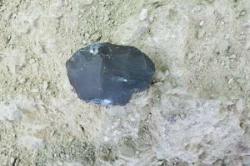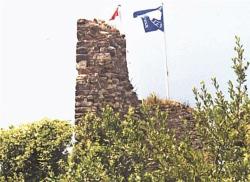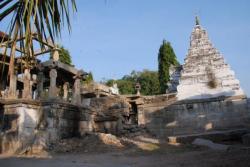INSTITUT SUPERIEUR D'ANTHROPOLOGIE
INSTITUTE OF ANTHROPOLOGY
ONLINE COURSES / COURS A DISTANCE
FALL TERM : OCTOBER 2015
REGISTER NOW
IRAN –  Mirak - Hamed Vahdati-Nasab who is the head of an Iranian-French archeological team, further remarked that studies will be continued and research works will be conducted on stone tools and animal remains by Iranian researchers at France National Science Center (CNRS). He expressed the hope that by finalization of laboratory studies a brighter image will be provided on the date of the existence of man in this geographical region. The archeologists pointed to the discovery of evidence attesting to the presence of the Neanderthal man of middle paleolithic, a period dating back to 40 to 50 thousand years ago, in Semnan’s Mirak. He also mentioned gaining access to the depths of the human settlement, elucidation of ancient climatic condition of the area and absolute chronology for human settlements as the main targets of the primary excavations. He said sedimentary findings reveal that Mirak Desert which is a dry area once had been a wet environment and perhaps a wetland or a semi-forest region. Mirak and Delazian regions which are also known as Mirak and Delazian Hills were first identified during archeological studies in the year 1364 (1985-86). The most important characteristic of the two regions is the very wide distribution of stone tools on the ground of the area. Later, in 1387 (2008-2009), random samplings were made by Vahdati-Nasab in Delazian and the result was forwarded to the Ancient Middle East Archeological Congress in Sapienza University of Rome. Next year, Vahdati-Nasab and his accompanying delegation were commissioned to conduct systematic sampling in Mirak and Delazian and classify the collected objects. The second season of archeological studies which started in 2009 at the head of Vahdati-Nasab with the collaboration of experts of the French National Science Center concluded after five years.
Mirak - Hamed Vahdati-Nasab who is the head of an Iranian-French archeological team, further remarked that studies will be continued and research works will be conducted on stone tools and animal remains by Iranian researchers at France National Science Center (CNRS). He expressed the hope that by finalization of laboratory studies a brighter image will be provided on the date of the existence of man in this geographical region. The archeologists pointed to the discovery of evidence attesting to the presence of the Neanderthal man of middle paleolithic, a period dating back to 40 to 50 thousand years ago, in Semnan’s Mirak. He also mentioned gaining access to the depths of the human settlement, elucidation of ancient climatic condition of the area and absolute chronology for human settlements as the main targets of the primary excavations. He said sedimentary findings reveal that Mirak Desert which is a dry area once had been a wet environment and perhaps a wetland or a semi-forest region. Mirak and Delazian regions which are also known as Mirak and Delazian Hills were first identified during archeological studies in the year 1364 (1985-86). The most important characteristic of the two regions is the very wide distribution of stone tools on the ground of the area. Later, in 1387 (2008-2009), random samplings were made by Vahdati-Nasab in Delazian and the result was forwarded to the Ancient Middle East Archeological Congress in Sapienza University of Rome. Next year, Vahdati-Nasab and his accompanying delegation were commissioned to conduct systematic sampling in Mirak and Delazian and classify the collected objects. The second season of archeological studies which started in 2009 at the head of Vahdati-Nasab with the collaboration of experts of the French National Science Center concluded after five years.
http://www.irna.ir/en/News/81692351/?
TURQUIE –  Akçakoca - Restoration work will begin next year at a Genoese castle, which is on UNESCO’s Temporary World Heritage List, in the Black Sea province of Düzce, officials have said. The Culture and Tourism Ministry commenced a project to renovate and reanimate the original appearance of the ancient castle, which was built by the Genoese people 800 years ago, said Cüneyt Yemenici, the mayor of Akçakoca in Düzce.
Akçakoca - Restoration work will begin next year at a Genoese castle, which is on UNESCO’s Temporary World Heritage List, in the Black Sea province of Düzce, officials have said. The Culture and Tourism Ministry commenced a project to renovate and reanimate the original appearance of the ancient castle, which was built by the Genoese people 800 years ago, said Cüneyt Yemenici, the mayor of Akçakoca in Düzce.
http://www.hurriyetdailynews.com/restoration-work-to-begin-at-historic-genoese-castle-.aspx?pageID=238&nID=85819&NewsCatID=375
ROYAUME UNI –  Norwich - A well-preserved human skeleton found on the former site of a medieval Augustinian friary could date from the 14th century, say archaeologists who have discovered pottery, coins, oyster shells and painted glass during work to create a housing development in Norwich. The skeleton was found in a tomb inside a church at St Anne’s Quarter, where the friary was dissolved during the 16th century before the grounds passed to the Duke of Norfolk, who built the listed Howard House. “We know a lot of activity took place at this site in the Saxon era, so these items are helping us to build a better of picture of the local history,” says Max Barnes, of Orbit Homes, who believes a silver-gilded dress fastener, likely to be declared treasure, dates from at least 300 years ago.
Norwich - A well-preserved human skeleton found on the former site of a medieval Augustinian friary could date from the 14th century, say archaeologists who have discovered pottery, coins, oyster shells and painted glass during work to create a housing development in Norwich. The skeleton was found in a tomb inside a church at St Anne’s Quarter, where the friary was dissolved during the 16th century before the grounds passed to the Duke of Norfolk, who built the listed Howard House. “We know a lot of activity took place at this site in the Saxon era, so these items are helping us to build a better of picture of the local history,” says Max Barnes, of Orbit Homes, who believes a silver-gilded dress fastener, likely to be declared treasure, dates from at least 300 years ago.
http://www.culture24.org.uk/history-and-heritage/archaeology/art532647-archaeologists-find-well-preserved-14th-century-human-skeleton-on-site-of-medieval-augustinian-friary
FRANCE – Toulouse - Commencées le 10 juin dernier, les fouilles archéologiques de la basilique Saint-Sernin ont révélé des vestiges qui faciliteront la reconstitution physique des lieux. Un hôpital, un cimetière médiéval ou encore le fameux cloître datant du XIIe siècle sont autant de découvertes faites par l'équipe d'archéologue emmenée par Pierre Pisani. Tout autour de la Basilique Saint Sernin les fouilles préventives ont dévoilés de nombreuses traces du passé toulousain, «actuellement ont met au jour le cloître» glisse le chef du service archéologie de Toulouse métropole. L'édifice, était autrefois accolé à la basilique «il fut construit dans le style roman, il devait être similaire à celui de Moissac», dévoile Pierre Pisani. Des informations qui arrivent au fur et à mesure que les archéologues sondent le sol : «il ne reste malheureusement que les fondations, on sait juste que l'édifice faisait 40 mètres de côté». De maigres vestiges qui s'expliquent par l'histoire du bâtiment, «le cloître s'est vidé après le XIIIe siècle puis il a été vendu comme bien national lors de la révolution avant d'être utilisé comme carrière pour servir à d'autres constructions», évoque le responsable du chantier. Le domicile des chanoines s'est désagrégé au fil du temps alors que l'Abbaye de Toulouse était très riche. On estimait que ses terres couvraient 30 hectares et qu'elle exerçait un pouvoir de juridiction sur le bourg, tout ce rayonnement est devenu peau de chagrin.
http://www.ladepeche.fr/article/2015/07/23/2148256-le-cloitre-medieval-de-saint-sernin-devoile.html
INDE –  Nalgonda - An estimated 25 of the 57 ancient historic sites in Nalgonda district, classified by the Department of Archaeology and Museums as protected under Andhra Pradesh Ancient and Historical Monuments Archaeological Sites and Remains Act 1960, have disappeared due to the apathy of successive governments in the State. A majority of these monuments were Megalithic burial sites dating back to 10th Century BC to 25th Century BC. In most cases, the farmers encroached these burial sites and brought them under cultivation unaware of their archaeological significance. The district was having second highest number of monuments identified under the Act, second only to Mahabubnagar, which had 59 protected monuments. According to the department 10 protected monuments in Mahabubnagar district also disappeared. Authorities in the department have no clue as to how many of the protected monuments were still intact, since there has been no survey in the recent years to study the status of these monuments.
Nalgonda - An estimated 25 of the 57 ancient historic sites in Nalgonda district, classified by the Department of Archaeology and Museums as protected under Andhra Pradesh Ancient and Historical Monuments Archaeological Sites and Remains Act 1960, have disappeared due to the apathy of successive governments in the State. A majority of these monuments were Megalithic burial sites dating back to 10th Century BC to 25th Century BC. In most cases, the farmers encroached these burial sites and brought them under cultivation unaware of their archaeological significance. The district was having second highest number of monuments identified under the Act, second only to Mahabubnagar, which had 59 protected monuments. According to the department 10 protected monuments in Mahabubnagar district also disappeared. Authorities in the department have no clue as to how many of the protected monuments were still intact, since there has been no survey in the recent years to study the status of these monuments.
http://www.thehindu.com/news/national/telangana/ancient-monuments-lost-forever/article7452842.ece
ROYAUME UNI –  Findhorn Bay - A campaign has been launched to restore a rare collection of Scottish fishing boats before they fall victim to coastal erosion. The so-called Zulu boats were favoured by herring fishermen at Findhorn Bay on the Moray Firth. But the vessels were abandoned when the fishermen left to fight in the First World War and have been left to rot ever since. he Zulu boats were built to the carvel method of planking, which was much stronger than the clinker system. The shape of the Zulus gave the boats a long deck but a shorter keel, which greatly improved their manoeuvrability. Zulus were two-masted boats and carried three sails – fore, mizzen and jib. The sails were very heavy and difficult to haul, and the masts had to be very long and strong. “Their design produced very fast boats that became invaluable to herring fishing fleets. They got to the fishing grounds quickly and returned swiftly with the catch. Because of these qualities, the Zulus rapidly became very popular along the entire East Coast. As the 20th century approached, steam capstans were introduced, and this made the hauling of the sails and nets easier for the crews
Findhorn Bay - A campaign has been launched to restore a rare collection of Scottish fishing boats before they fall victim to coastal erosion. The so-called Zulu boats were favoured by herring fishermen at Findhorn Bay on the Moray Firth. But the vessels were abandoned when the fishermen left to fight in the First World War and have been left to rot ever since. he Zulu boats were built to the carvel method of planking, which was much stronger than the clinker system. The shape of the Zulus gave the boats a long deck but a shorter keel, which greatly improved their manoeuvrability. Zulus were two-masted boats and carried three sails – fore, mizzen and jib. The sails were very heavy and difficult to haul, and the masts had to be very long and strong. “Their design produced very fast boats that became invaluable to herring fishing fleets. They got to the fishing grounds quickly and returned swiftly with the catch. Because of these qualities, the Zulus rapidly became very popular along the entire East Coast. As the 20th century approached, steam capstans were introduced, and this made the hauling of the sails and nets easier for the crews
http://www.scotsman.com/lifestyle/heritage/fight-to-save-remains-of-zulu-boats-on-moray-coast-1-3838405
EGYPTE – Gizeh - t’s a puzzle that has had Egyptologists scratching their heads for decades. What look like air shafts in the Great Pyramid of Giza are blocked from the outside and no definite explanation has been found so far as to their meaning or where they lead to. But a team at Leeds University is hoping to uncover one of the world’s oldest secrets with its so-called Djedi robot. It’s not the first time a robot has explored the inside of the tiny shafts within the great pyramid of Giza. But so far, none have been small or nimble enough to reach the end of the shafts. Djedi’s creators hope this one will succeed and help uncover some of the secrets of the pyramids. “What our robot here does is, using these four soft pads that brace against the shaft walls, once it moves these never move and braze away. So it’s a very low impact method of travelling inside the air shafts,” explains research student Jason Liu. Djedi was built using a 3D printer, which allowed the team to print parts of the robot that are both complex and resistant. It is also equipped with cameras and a miniature ultrasonic device that can tap on walls and get a response to help determine the thickness and condition of the stone.
VIDEO = http://www.euronews.com/2015/07/23/robot-tries-to-unlock-giza-pyramid-s-secrets/
GUATEMALA - La Corona - Archaeologists working in northern Guatemala have uncovered three well-preserved Mayan panels dating backing around 1,400 years. The panels display ancient hieroglyphics that provide insights into the civilisation's royal traditions along with a stone image of a king. The priceless artefacts have been moved to Guatemala City for further research. Marcelo Canuto, co-director of La Corona Archaeological Project, describes the importance of the find.
VIDEO = http://www.bbc.co.uk/news/world-latin-america-33632728